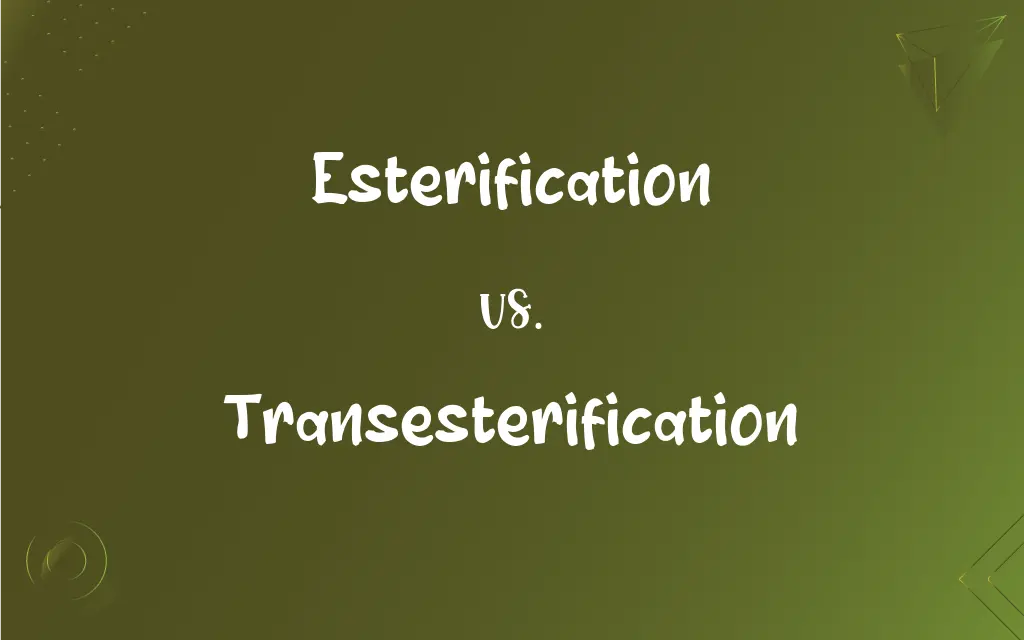Esterification vs. Transesterification: What's the Difference?
Edited by Aimie Carlson || By Janet White || Updated on November 28, 2023
Esterification is the formation of an ester from an acid and an alcohol, while transesterification is the exchange of an ester's alkoxy group with another alcohol.

Key Differences
Esterification is a chemical reaction where an alcohol and an acid react to form an ester and water. Transesterification, however, involves the reaction of an ester with an alcohol, leading to the formation of a different ester.
In esterification, the functional groups of the acid (carboxyl group) and the alcohol (hydroxyl group) are key players. In transesterification, the focus is on the alkoxy group of the ester being exchanged with the alcohol's hydroxyl group.
Esterification is typically catalyzed by acids, resulting in the release of water as a byproduct. Transesterification, on the other hand, often requires a catalyst, such as an acid or base, but does not produce water.
The purpose of esterification is often to synthesize esters used in flavors, fragrances, and polymers. Transesterification is commonly used in the production of biodiesel, where esters are converted to more suitable forms for fuel.
Esterification can be reversible or irreversible depending on the conditions. Transesterification is typically reversible, allowing for the adjustment of the reaction until the desired ester is formed.
ADVERTISEMENT
Comparison Chart
Reaction Components
Alcohol and acid
Ester and alcohol
Byproduct
Water
Another ester
Catalysis
Often acid-catalyzed
Requires acid or base catalyst
Primary Use
Synthesis of esters for various applications
Production of biodiesel, adjusting ester properties
Reaction Nature
Can be reversible or irreversible
Typically reversible
ADVERTISEMENT
Esterification and Transesterification Definitions
Esterification
Esterification is a process where an alcohol and an acid react, releasing water.
Esterification reactions are key in synthesizing polyester materials.
Transesterification
Transesterification involves converting one ester into another using alcohol.
Transesterification is used to alter the properties of lipid-based substances.
Esterification
Esterification is the reaction of an alcohol with an acid to form an ester.
The esterification of acetic acid with ethanol produces ethyl acetate.
Transesterification
Transesterification is a reaction where an ester is transformed by another alcohol.
Glycerides undergo transesterification to form biodiesel and glycerol.
Esterification
Esterification involves forming an ester by condensing an acid and an alcohol.
Esterification is used in the perfume industry to create aromatic esters.
Transesterification
Transesterification refers to the reaction of an ester with an alcohol to form a new ester.
Transesterification is essential in the chemical recycling of plastics.
Esterification
Esterification is the formation of an ester from a carboxylic acid and an alcohol.
The esterification process is critical in producing flavors and fragrances.
Transesterification
Transesterification is the exchange of alkyl groups between esters and alcohols.
Biodiesel production uses transesterification of vegetable oils with methanol.
Esterification
Esterification refers to creating esters through acid-alcohol reactions.
In organic chemistry labs, esterification is a common experiment.
Transesterification
Transesterification is the process of exchanging the alkoxy group of an ester.
In the lab, transesterification is used to synthesize different types of esters.
Esterification
A chemical reaction resulting in the formation of at least one ester product.
Transesterification
(organic chemistry) The reaction of an ester with an alcohol in order to replace the alkoxy group; it is used in the synthesis of polyesters and in the production of biodiesel
Esterification
(organic chemistry) Any reaction (typically between an acid and an alcohol) that results in the production of an ester
[http://www.sigmaaldrich.com/etc/medialib/docs/Aldrich/Acta/al_acta_30_01.pdf Aldrichimica Acta Volume 30 No 4] (pdf) from [http://www.sigmaaldrich.com/chemistry/chemical-synthesis/learning-center/aldrichimica-acta.html Sigma-Aldrich]
FAQs
What is esterification?
It's forming an ester from an alcohol and an acid.
What types of catalysts are used in esterification?
Acid catalysts are commonly used.
What are the products of esterification?
An ester and water.
Is transesterification a reversible reaction?
Generally, it is reversible.
Is water a byproduct in transesterification?
No, transesterification does not typically produce water.
What’s a common use of esterification?
It's used in synthesizing flavors, fragrances, and polymers.
What catalysts are used in transesterification?
Both acid and base catalysts can be used.
What is transesterification?
It's the process of forming a new ester from an existing ester and an alcohol.
What are the products of transesterification?
A new ester and another alcohol or substance.
Can esterification be reversed?
Yes, under certain conditions, it can be reversible.
Can transesterification occur without catalysts?
It's possible but typically less efficient.
Is transesterification environmentally friendly?
It can be, especially in biodiesel production using renewable resources.
How is transesterification used in recycling?
In chemical recycling of plastics to break down and reform esters.
Can esterification be used in energy production?
Not directly, but its products like esters can be used in various applications.
How does esterification impact the environment?
It depends on the reactants and byproducts; some processes can be environmentally friendly.
What role does transesterification play in energy?
It's crucial in converting fats and oils into biodiesel, an alternative energy source.
What's a key application of transesterification?
Primarily in producing biodiesel.
Are acids always required for esterification?
They are typically required but not always.
What is a common esterification reaction in everyday life?
The formation of esters in soap making.
Are esterification and transesterification similar?
They both involve esters, but their processes and purposes are different.
About Author
Written by
Janet WhiteJanet White has been an esteemed writer and blogger for Difference Wiki. Holding a Master's degree in Science and Medical Journalism from the prestigious Boston University, she has consistently demonstrated her expertise and passion for her field. When she's not immersed in her work, Janet relishes her time exercising, delving into a good book, and cherishing moments with friends and family.
Edited by
Aimie CarlsonAimie Carlson, holding a master's degree in English literature, is a fervent English language enthusiast. She lends her writing talents to Difference Wiki, a prominent website that specializes in comparisons, offering readers insightful analyses that both captivate and inform.






































































